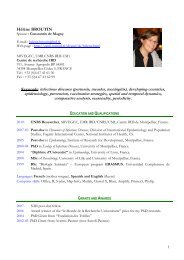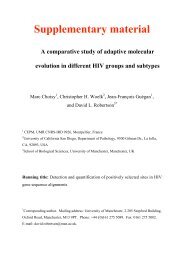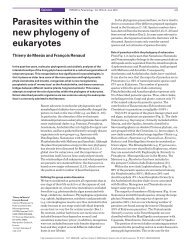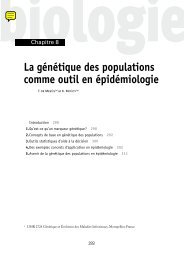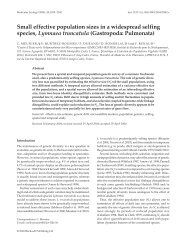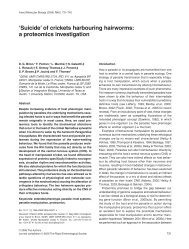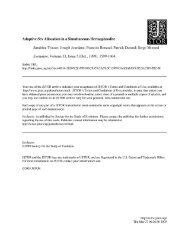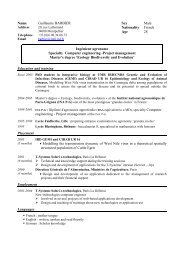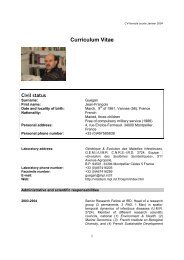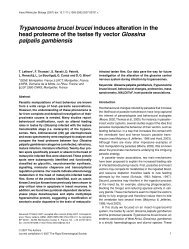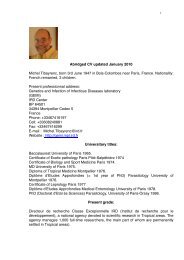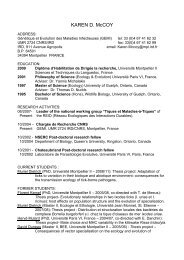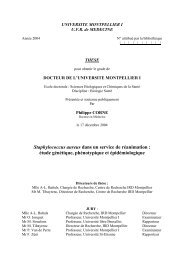écologie des virus influenza aviaires en Camargue - IRD
écologie des virus influenza aviaires en Camargue - IRD
écologie des virus influenza aviaires en Camargue - IRD
You also want an ePaper? Increase the reach of your titles
YUMPU automatically turns print PDFs into web optimized ePapers that Google loves.
SommaireIntroduction. 11. Zoonoses émerg<strong>en</strong>tes. 22. Maladies infectieuses et écosystèmes. 43. Virus <strong>influ<strong>en</strong>za</strong> <strong>aviaires</strong> <strong>en</strong> <strong>Camargue</strong>. 54. Objectifs et questions abordées. 7Chapitre I: Activités humaines, parasitisme et écosystèmes. 91. Activités humaines et évolution <strong>des</strong> pathogènes. 102. Surpeuplem<strong>en</strong>t <strong>des</strong> espaces protégés et transmission de pathogènes. 10Chapitre II: Influ<strong>en</strong>za <strong>aviaires</strong> <strong>en</strong> <strong>Camargue</strong>. 311. Écologie et évolution <strong>des</strong> <strong>virus</strong> <strong>influ<strong>en</strong>za</strong> <strong>aviaires</strong>. 311.1. Généralités. 311.2. Hôtes naturels et cycle viral. 311.3. Évolution virale. 331.4. Virus hautem<strong>en</strong>t pathogènes. 332. Préval<strong>en</strong>ces d'infections chez les oiseaux sauvages <strong>en</strong> <strong>Camargue</strong>. 342.1. Échantillonnage. 352.2. Biologie moléculaire et virologie. 362.3. Analyse statistique. 372.4. Résultats et discussion. 373. Id<strong>en</strong>tification <strong>des</strong> <strong>virus</strong> circulant. 423.1. Méthodologie. 423.2. Premiers résultats. 434. Les écosystèmes aquatiques: réservoir naturel de <strong>virus</strong> <strong>influ<strong>en</strong>za</strong> <strong>aviaires</strong> ? 44Chapitre III: Émerg<strong>en</strong>ce du <strong>virus</strong> H5N1 hautem<strong>en</strong>t pathogène. 911. Le <strong>virus</strong> H5N1 HP chez les oiseaux sauvages. 922. Introduction et circulation du <strong>virus</strong> H5N1 HP <strong>en</strong> <strong>Camargue</strong>. 933. Persistance <strong>des</strong> <strong>virus</strong> hautem<strong>en</strong>t pathogènes dans les écosystèmes naturels. 94Discussion générale et perspectives. 1451. Écologie <strong>des</strong> <strong>virus</strong> <strong>influ<strong>en</strong>za</strong> <strong>aviaires</strong>. 1451.1. Dynamique temporelle d'infection. 1451.2. Détection de <strong>virus</strong> chez les larolimicoles. 1461.3. Rôle réservoir <strong>des</strong> écosystèmes aquatiques. 1472. Maladies infectieuses émerg<strong>en</strong>tes et écosystèmes. 1482.1. Émerg<strong>en</strong>ce de <strong>virus</strong> <strong>influ<strong>en</strong>za</strong> <strong>aviaires</strong> et modification <strong>des</strong> écosystèmes. 1482.2. Activités humaines, maladies infectieuses et écosystèmes. 150Référ<strong>en</strong>ces bibliographiques. 153



